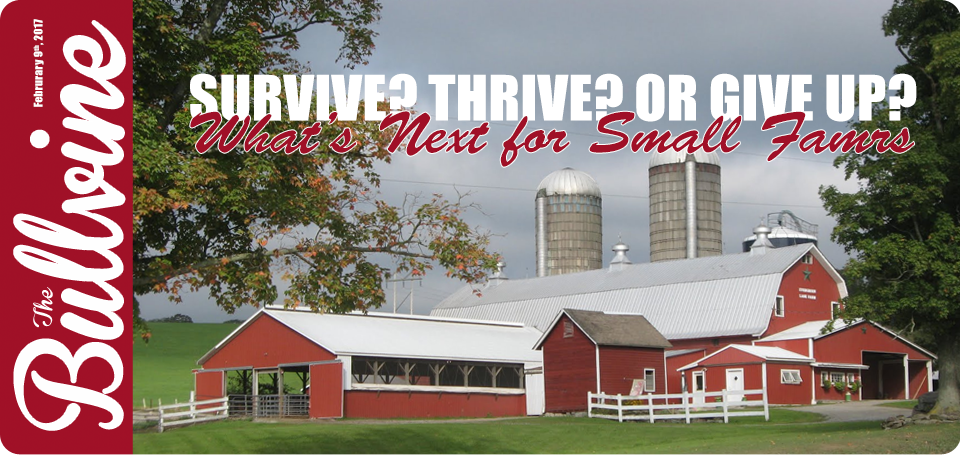Even in the best of times, small farms struggle to remain profitable. Dairy producers have come through years of pressure from all sides of the industry – economic, political and environmental – to name only a few. Many, regardless of size, are having serious concerns about the future of their dairy farm.
Before we look at this question, we have to set some parameters. Let’s begin with a look at what defines a small farm. Are we talking the romanticized version of dairy farming which non-dairy perception mostly pegs at 30 milking cows or less? Or are we closer to today’s reality? In the USA small now means herds with fewer than 100 milking cows. In Canada, the cross Canada numbers might peg small at 50 milkers.
The second major question is, “Do we want small farms to merely survive? Or do we want them to thrive? The global and North American dairy community has been through almost a decade of economic crisis. If you’re small and still here, you have figured out how to survive? But is survival a benefit to our families, our communities or the dairy industry?
Popular advice would say that smaller farms should cut back during adverse periods. Others would say, focus on highly specific market segments. Both options assume that small dairy producers are willing to be proactive and aggressive even as the economic returns continue to shrink. At this point, either option seems somewhat ludicrous.
In the worst of times, when waning consumer demand combined with falling milk prices is hitting their bottom line right beside rising labor and feed costs, small farms face an even steeper climb. Admittedly, some small businesses, usually outside of agriculture, adapt to adversity by turning to new products, services or processes. Small dairy farms in survival mode are in no position to take these initiatives. Like deer in the headlights they are almost frozen in place not thinking of aggressive strategies.
Reports to the National Milk Producers Federation recently stated that, “Its far more lucrative to operate large-scale dairy farms with 500 cows or more.”
At the same time that small dairy farms struggle, their larger dairy counterparts who produce larger volumes can take advantage of their greater income to consider automation of their milking operations. This means they have more strategic options despite economic downturns.
Some analysts still say that small farms have the advantage. While large farms are hampered by their size, small farms can change their plan or tactics much faster. While the larger operations are studying options, small farms can make a quick turnaround. This looks good in theory, but in actual fact all dairy farms are dealing with live animals, financial constraints, and the immediacy of providing the cash flow necessary for the maintenance of the operation and the day-to-day needs of the people and livestock depending upon it.
Larger farms, and particularly growing ones, are more competitive, invest more, offer better wages and benefits and are more likely to contribute to export markets. Put simply, growing farms, not small ones, drive economic growth. Governments should want more growth but policies are sending exactly the opposite signal: “Stay small. Don’t grow.”
Small may be beautiful but not when it gets to the point of recklessness. We cheer when headlines announce that government plans to give small farms and small business in general a break. Surely, they deserve special help – in order to survive in a world that is more and more dominated by everything big: big business, big box stores, big, big, big. Ironically there may be farms that are consciously choosing to remain small to remain eligible for government assistance.
Small may be beautiful, but not if it becomes a roadblock. It’s unfortunate when popular politics doesn’t actually represent what is good for the economy. Handouts and tax breaks may even cause harm by creating a perverse discouragement for growth. It takes growing companies to drive economic growth. For small farms that means that political and financial policies are sending exactly the opposite message: “Stay small. Don’t grow.”
It’s time for governments and lenders to encourage strategies that encourage growth.
For example, in 2013 the Canadian Federal Finance department pointed out that small businesses, which would include smaller farms, “play an important role in the economy,” and tax breaks help them “retain more of their earnings for investment, expansion and job creation.” However, there is no evidence to support these objectives and one is left to conclude that the voting block represented by 600,00 voters is more of a political incentive than an economic one.
Will Political Agendas Backfire? Further along this line of considering how political agendas diverge from farm reality, are the issues of international trade and protectionism. On the one hand watching government leadership proclaim support for agriculture by making protectionist moves against trade agreements and foreign goods being blocked from competition, seems to support both small and large dairy operations. In reality, in the US, when such barriers come into play, it merely allows other international competitors to scoop up markets that, before US withdrawal, saw themselves as too small to compete in. While North America goes into “I don’t wanna play in your yard” mode, the rest of the world greedily anticipates cherry picking in their former markets.
The Bullvine Bottom Line
For small dairy farms, these continuing periods of financial turmoil and the competition from more and more large dairy farms, means that they face a unique set of challenges. Selecting a strategy for the future will directly impact whether small dairies thrive, survive or give up.

Get original “Bullvine” content sent straight to your email inbox for free.















Leave a Reply
You must be logged in to post a comment.